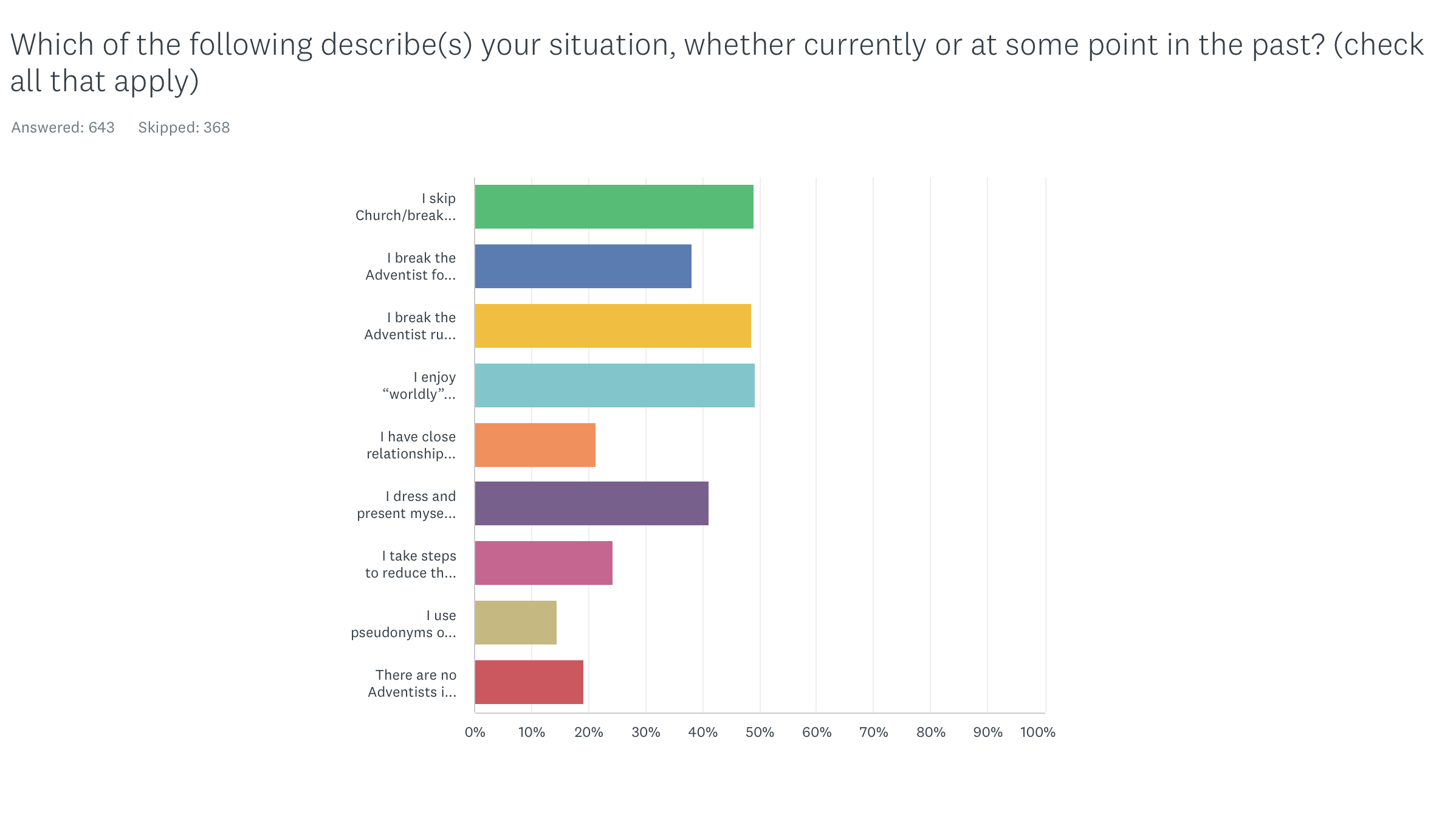Below are the data from Q16 in our survey. Please reach out if you have any questions or comments.
Q16: Which of the following describe(s) your situation, whether currently or at some point in the past? (check all that apply)


ChatGPT-4 analysis 9-22-23
Individuals’ Experiences and Perspectives Regarding Adventist Rules and Beliefs
Executive Summary:
This report synthesizes diverse experiences and perspectives on adherence to Seventh-day Adventist (SDA) rules and beliefs. Numerous themes emerged, portraying a shift from past concealment to contemporary openness regarding Adventist values.
1. Evolution from Concealment to Openness:
1.1 Past Concealment:
Many individuals previously concealed aspects of their lives that were in conflict with Adventist rules.
Example: “These are things I did in the past when I was much younger. I’m not hiding anything now.”
1.2 Acceptance of Present Self:
A shift towards acceptance and openness about divergent lifestyles is noted.
Example: “I am open about not being an Adventist, but I don’t go out of my way to point it out.”
2. Current Honesty and Integrity:
2.1 Open Lifestyle:
Many respondents live openly divergent lives without feeling the need to hide their beliefs and lifestyles.
Example: “I don’t hide anything. I’m proud that I’m no longer SDA.”
2.2 Maintaining Integrity:
Maintaining personal integrity is paramount, with no desire to lie about lifestyles.
Example: “This is an utterly ridiculous question. I have maintained my integrity at all times. Why should I lie to people about my behaviours?”
3. Limited Interaction and Selective Sharing:
3.1 Restricted Adventist Connections:
The interaction with Adventists is often limited to close friends or family.
Example: “I have only close friends who are Adventist. No acquaintance level people are Adventist.”
3.2 Consideration for Adventist Individuals:
There is a deliberate effort to avoid causing distress to Adventist acquaintances.
Example: “I don’t normally hide/lie about it, but don’t bring things up when visiting my mom (I don’t live near her)”
4. Non-Conformity to Traditional Norms:
4.1 Non-Traditional Relationships:
Non-heteronormative or polyamorous relationships were often concealed.
Example: “The only thing I really hid was when I was in a polyamorous or queer relationship.”
4.2 Secular Lifestyle:
Embrace of secular lives and rejection of religious dogma is evident.
Example: “I do everything publicly now, and not afraid to show what my daily life is like. We all mature out of religion.”
5. Relationship Dynamics:
5.1 Familial Respect and Sensitivity:
A respectful and sensitive approach is maintained around family members with strong Adventist beliefs.
Example: “I hide “sabbath-breaking” from my family even though they know I left because it’s too traumatic for them and causes them too much anxiety.”
5.2 Balance of Openness and Respect:
A balance between openness and respect is sought to maintain harmonious relationships.
Example: “I don’t hide lack of SDA beliefs but I don’t flaunt them either.”
Conclusion:
The narratives portray a rich tapestry of experiences, reflecting a journey from concealment to openness and from adherence to divergence. The desire for personal integrity and respect for differing beliefs underscores the narratives, pointing towards a conscientious approach to navigating relationships with Adventist acquaintances. The diverse responses collectively shed light on the broader themes of secularization, the pursuit of authenticity, and the evolving dynamics of religious identity and values within the context of Seventh-day Adventism.


 Follow
Follow